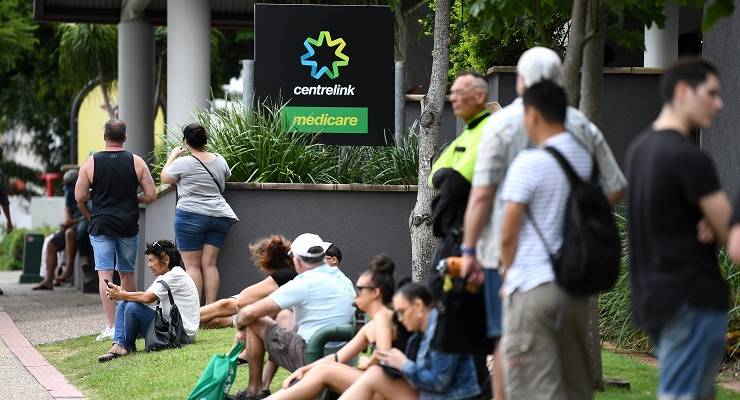
If there was any reason to wind down JobKeeper at the weekend, the need for fiscal discipline wasn’t it.
Friday’s financial statement from Finance Minister Simon Birmingham showed the budget deficit running $23 billion under estimate; in February the budget deficit increased by only $700 million after rising by almost $18 billion in January.
The Australian Bureau of Statistics’ (ABS) examination of the Commonwealth government and Reserve Bank’s (RBA) accounts, also released last week, shows how borrowings by the Morrison government surged in the three months to last September, and then plunged in December (it was a similar story for state government borrowings).
The ABS showed the Commonwealth had net borrowings of $194.8 billion in calendar year 2020, which was “met by high demand from investors, particularly from overseas (due to their yields being higher than other internationally comparable bonds)”. But as the economy recovered better than expected, the government needed less money. Its deposits with the Reserve Bank reached a record $131.6 billion at the end of September quarter.
In December quarter 2020, the government reduced their bond issuance, and net borrowing declined to $33.2 billion due to reduced JobKeeper and boosting cashflow for employers subsidies paid to businesses. The Commonwealth government funded the majority of these COVID-19 related subsidies and expenditure through their RBA deposit accounts. Despite this drawdown of deposits, government deposit assets remain at elevated levels ($100.4 billion as at December 31, 2020).
That leaves the Commonwealth ample funds to continue with fiscal stimulus until June 30 at the reduced JobKeeper rate that started in December.
The states had a similar experience.
State governments supported their economies through the COVID-19 pandemic through record net borrowing of $89.8b in calendar year 2020 … State governments financed this expenditure through the issuance of semi-government bonds … Excess borrowed funds saw deposit assets rise to a record high of $77bn by the end of the September quarter, of which $1.9bn was drawn down to help fund expenditure in the December quarter 2020.
In other words, state governments had $75.1 billion in cash on hand at the end of 2020.
Just because the money has already been borrowed doesn’t mean governments should spend it, of course. But there are compelling reasons to avoid the mistakes made in Europe and the US after the financial crisis of withdrawing stimulus too early. In any event, the pandemic isn’t over yet — Brisbane will go back into lockdown tonight while the government struggles with a painfully slow vaccine rollout.
Remember that the Reserve Bank insists wages growth is the key to returning to normal monetary policy, and there’ll be no wages growth without either the government embracing policies to deliver it — which looks highly unlikely when it continues to try to suppress wages growth — or unemployment drops to the low 4s and produces a labour market tight enough to force employers to stop profiting off workers’ productivity and give them a pay rise.
That may take longer than people think. The economic forecasts from US Federal Reserve two weeks ago suggest the Fed doesn’t believe — even with President Biden’s massive stimulus program and further infrastructure stimulus potentially in the works — that unemployment will return to pre-pandemic levels until 2023.
Those low levels of unemployment in the US — below 4% — were sufficient to drive modest wages growth, although nothing spectacular, and not enough to push up inflation. A return to pre-pandemic unemployment levels here would simply entail more wage stagnation of the kind Australian workers have endured for the best part of a decade.
Should the government keep the JobKeeper program running? Write to letters@crikey.com.au. Please include your full name to be considered for publication in Crikey’s Your Say section.









This mob will only spend money if it goes to their mates.
Bushfire fund still has not been spent.
NDIS is starved of funds and set to be done over again by the holy tour guide and internet scammer Gollum Robert.
Unemployed below poverty level again.
Meanwhile negative gearing is still inflating the property bubble and shareholders who don’t pay tax get tax rebates anyway.
Still no requirement for billionaires to pay any meaningful tax on their I’ll gotten gains.
Australia, the lucky country (for you but not for me).
All unbelievable but true! How did we come to this??? Rhetorical question sadly… GREED!
Neoliberal economic policies worldwide have given us low wages, excessive profits, under employment & casual labour. Many more issues of course including climate change denial. Our LNP politicians are mirror images of the most rabid republicans of the USA.
The term “borrowing” refers to issuing bonds to large organisations, especially in the financial industry, who see it as a safe form of investment. But this is a choice, not a necessity, since the dollar is a fiat currency, and the Government can fund almost anything without the requirement to pay interest. Can we expect those financial industries use these investments for social purposes, such as public housing or better health care?
Bernard and Glenn seem to have missed that the Reserve has bought something like $200B in bonds on the secondary market, and as the Reserve and govt are essentially the same as mum borrowing from dad, or vice versa, it appears we are well in front.
Muppets.
This is the muppets, quintessentially. No policy in nearly 9 years can be explained by an intention to benefit citizens. It’s perverted guiding light is, and explains every muppet policy, benefit donors first, benefit business over citizens second and discretionary social spending gets targeted at winning elections. No government since federation has been so malignant to the common good.
#JoshFromAccounts confirmed that when admitting that JobKeeper was designed so that public funds could not be recovered from payees who objectively did not qualify or outright defrauded the system. This was not inadvertence in the face of a crisis, it was intentional.
“or unemployment drops to the low 4s and produces a labour market tight enough to force employers to stop profiting off workers’ productivity and give them a pay rise.”
More like high or mid 2%.
US unemployment got down to 3.8% with not the slightest indication that this was feeding into higher wages. More classical economics goofery.